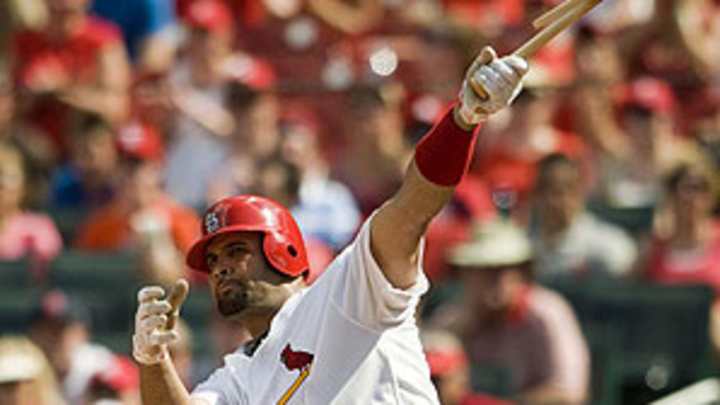Don't count out Albert Pujols even after stunningly slow start


If Jose Bautista is the game's biggest positive surprise this year, then Albert Pujols is its biggest negative one. The 31-year-old first baseman, who hit the ground running on Opening Day 2001 and has never had a season in which he finished outside the top 10 in NL MVP balloting, is hitting .261/.330/.407 as we near the one-third mark of the 2011 season.
Pujols has never had numbers anything like this on Memorial Day, and in fact, has rarely never hit for a full month (at least 50 PA) the way he has for the first two of this season. His worst three months, previously, are shown in the chart at right:
It's important to put Pujols' lost spring into some perspective. For one, consider that he's still an above-average batter, with an adjusted OPS (OPS+) of 106 (an OPS six percent above league average when taking ballparks into account). Like everyone else, Pujols' numbers have been affected by the league-wide decline in offense, and his stats look worse than they are. More perspective? Pujols isn't even alone on his own team in having a performance that far out of line with career norms, or even expectations. The difference between Lance Berkman's 2011 OPS+ (210, on a line of .350/.463/.650) and his career mark (146) is exactly the same absolute figure, 64 points, as Pujols' difference. It's certainly unusual for Pujols to be hitting so poorly, but still within the range of possible outcomes for two months of baseball.
Any slump of this nature will reflect a mix of luck and skill. We measure luck in hitters in two primary ways: their home runs as a percentage of fly balls, and their batting average on balls in play. Both numbers, for Pujols, are below his career norms. Since 2002 (as far back as Fangraphs has data), Pujols has hit about one of every five fly balls out of the yard. This season, that figure is one in eight. The league is down in this area to its lowest mark since 1992, but that doesn't account for Pujols' change. The difference has cost him two or three home runs. Pujols has also dropped from a career BABIP of .315 to .253. That sixty-point difference accounts for much of the gap between his .330 career mark coming into 2011 and the .261 he sports today.
That BABIP, though, is itself a mix of luck and skill, and this is where we find the most frightening part of Pujols' 2011. A low batting average on balls in play is in part caused by a lack of hitting the ball hard, and Pujols is posting the lowest line-drive rate (14.8 percent of balls in play) and highest groundball rate (49.5 percent of balls in play) of his career. He's losing all kinds of hits because he's not squaring up the ball and driving it the way he has before now.
An increase in groundball rate -- albeit from a higher base to league-leading levels -- has been a key element in the sharp decline of Derek Jeter, and can be seen in late-career decline. Mechanically, it can mean a player is getting beat with fastballs, unable to get the bat head to them. Statistically -- and you'll want to take this data with a grain of salt because of the sample sizes involved -- Pujols has lost more of his established performance against fastballs and sliders than he has against cutters, curves and change-ups. It's an open question as to whether anyone's noticed, but he may be being pitched differently: Pujols is seeing a higher percentage of fastballs and first-pitch strikes than he has in some time. He's taking the same approach to the plate; when you account for intentional walks -- which have disappeared thanks to Berkman -- Pujols' strikeout and walk rates are basically unchanged, and he's taking and swinging at the same number of pitches as he ever has.
All of this is in the past, however, and while the past is fairly predictive in baseball, the short-term past is much less so. Streaks in which a player hits this far above or below his norms do happen, whether it's Berkman or Bautista going off at an MVP level for two months or Frank Thomas collapsing to a .265 average -- for an entire season -- at age 30. We simply underestimate the natural level of variance in player performance over any length of time. While I do take the uptick in groundball rate and fastballs seen as possible evidence of a larger problem, I'm more influenced by the decade of excellence that came before. Pujols may be out of his peak, no longer the very best player in baseball and prone to longer slumps but he's still an exceptional hitter and will soon enough return to his established level.
From this point forward, expect Pujols to hit preseason expectations. In broad terms, that means a .310 average, .415 OBP and .600 SLG. He'll crank out 20-25 home runs and about that many doubles. His total line for 2011 will be the worst of his career -- .290/.380/.520 or so -- but the way in which he finished will quell doubts that he is still on pace to be the best first baseman in baseball history.
